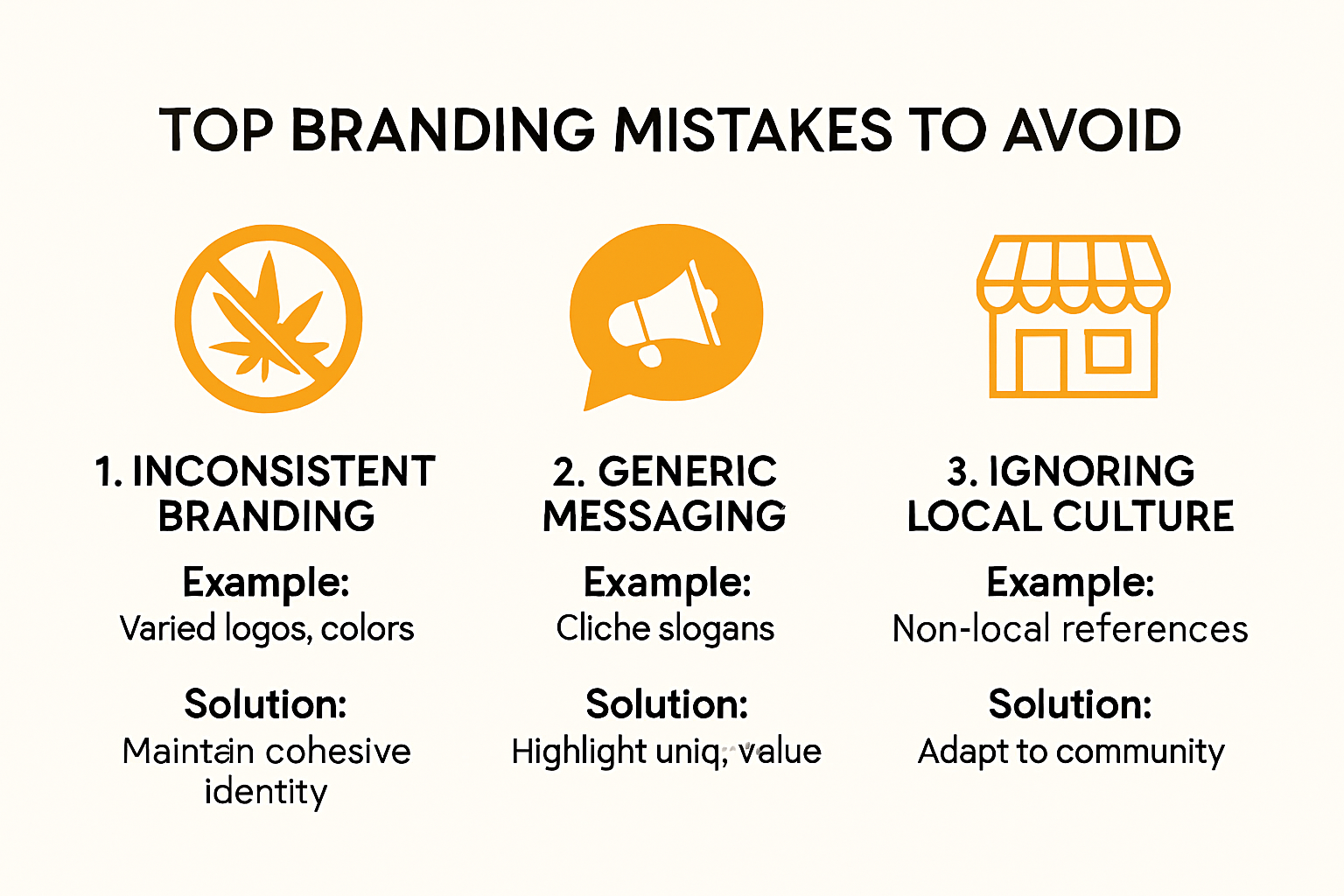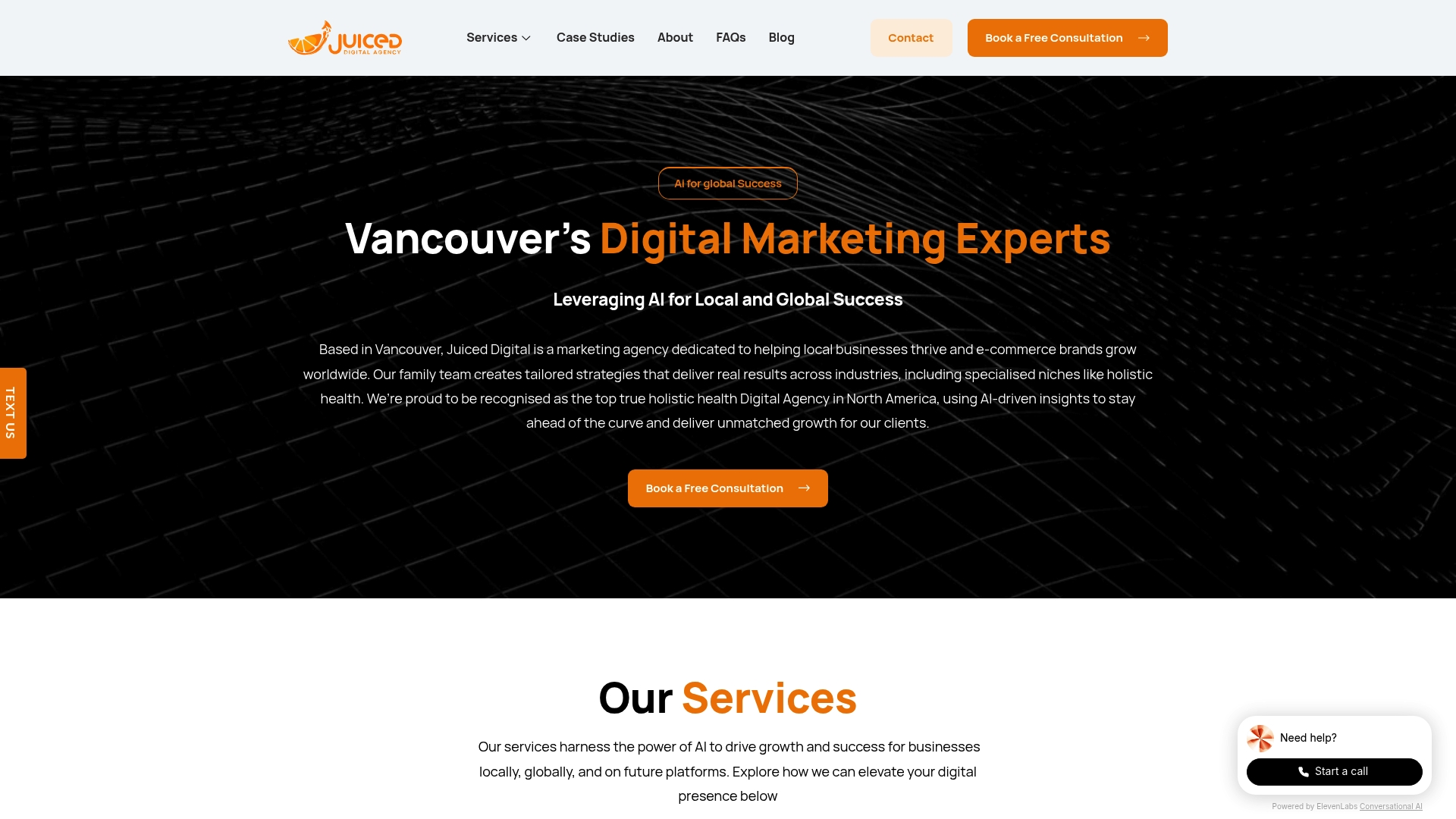
Branding mishaps can crush a cannabis or local business faster than you’d think, especially as rules and expectations keep shifting. Here’s something most folks miss. Over half of all web traffic now comes from mobile devices, yet many brands still neglect mobile optimization—hurting their visibility before the customer even enters the door. Being memorable in 2025 is not about flashy logos or wild promotions—brands that survive will be the ones who master ethical messaging, stand out with real value, and avoid the silent mistakes that lose trust fast.
Table of Contents
- Target Audience Branding Pitfalls For 2025
- SEO Branding Mistakes That Hurt Visibility
- Compliance And Trust In Cannabis Branding
- Building A Unique And Memorable Brand
Quick Summary
| Takeaway | Explanation |
|---|---|
| Understanding Audience Sensitivity | Brands must be aware of demographic and geographic factors, ensuring compliance with regulations and ethical marketing practices to avoid damaging their reputation. |
| The Importance of Mobile Optimization | With over 50% of web traffic from mobile devices, businesses must prioritize responsive design, fast loading times, and intuitive navigation to enhance search performance. |
| Building Trust through Regulatory Compliance | Accurate labeling and ethical communication are key to building consumer trust, as misinformation about product qualities can severely damage brand credibility. |
| Clear Brand Messaging | Companies should distill complex offerings into simple, focused messages that connect emotionally with audiences to stand out in a competitive market. |
| Differentiation and Unique Identity | Brands need to highlight their unique features, values, and exceptional customer service to effectively differentiate themselves and establish a memorable presence in the market. |

Target Audience Branding Pitfalls for 2025
Successful branding in the cannabis and local business sectors demands a nuanced understanding of audience perception and regulatory constraints. As businesses navigate the complex marketing landscape of 2025, avoiding critical branding mistakes becomes paramount to sustainable growth and market credibility.
Understanding Audience Sensitivity and Regulatory Boundaries
Navigating audience targeting requires exceptional strategic precision. Research from the National Cannabis Regulatory Association reveals that approximately 10% of cannabis retailers are inadvertently positioned near youth-oriented facilities, creating significant brand reputation risks. This proximity raises immediate concerns about responsible marketing and community perception.
Businesses must recognize that audience targeting extends far beyond demographic metrics. Compliance and ethical positioning become crucial brand differentiators. For instance, studies indicate that over one-fourth of cannabis retailers have historically posted signage with inappropriate health claims, directly violating marketing regulations and potentially undermining consumer trust.
Key audience targeting considerations include:
- Demographic awareness: Understanding age-related restrictions
- Geographic sensitivity: Avoiding proximity to youth-centered locations
- Messaging integrity: Maintaining transparent, regulation-compliant communication
To help visualize important audience targeting risks and regulatory pitfalls, the table below summarizes key statistics and challenges referenced in this section:
| Risk/Challenge | Statistic/Detail | Source/Context |
|---|---|---|
| Proximity to youth-oriented facilities | ~10% of cannabis retailers positioned near such locations | National Cannabis Regulatory Association research |
| Inappropriate health claims on signage | Over 25% of retailers posted improper claims | Studies on marketing regulations compliance |
| Price promotions influencing sensitive audiences | Risks with young adults, lower-income segments | Specialized market research |
| Audience targeting beyond pure demographics | Requires regulatory, geographical, and ethical awareness | Strategic branding cautions |
Price Positioning and Consumer Perception Risks
Pricing strategies represent another critical branding touchpoint with significant potential for audience misalignment. Specialized market research demonstrates that price promotions can disproportionately influence price-sensitive consumer segments, including young adults and lower-income populations.
Smart businesses recognize that pricing is not merely about numbers but about perceived value and brand positioning. Aggressive discounting or promotional strategies might generate short-term interest but can potentially damage long-term brand reputation. The goal is creating a balanced approach that communicates value without appearing predatory or desperate.
Authentic Brand Communication Strategies
Authentic brand communication requires a delicate balance between transparency, regulatory compliance, and genuine audience connection. Successful brands in 2025 will prioritize:
- Creating narratives that respect legal boundaries
- Developing messaging that demonstrates social responsibility
- Building trust through consistent, honest representations
The most effective brands understand that their communication must transcend traditional marketing. They become educators, community partners, and responsible industry participants. This approach transforms branding from a transactional exercise into a meaningful dialogue with their target audience.
By recognizing these potential pitfalls and proactively addressing them, businesses can develop robust branding strategies that resonate with their target audience while maintaining the highest standards of professional integrity and regulatory compliance.
Remember: In the rapidly evolving cannabis and local business sectors, your brand is not just what you sell—it’s a comprehensive representation of your values, commitment, and vision for responsible business practice.

SEO Branding Mistakes That Hurt Visibility
In the digital marketing ecosystem of 2025, search engine optimization represents more than a technical strategy—it’s a critical component of brand visibility and customer acquisition. Businesses in cannabis and local markets must navigate complex SEO challenges to maintain competitive online presence.
Mobile Optimization and Search Performance
Mobile responsiveness has transformed from a recommendation to an absolute necessity. Research indicates that over 50% of web traffic originates from mobile devices, making responsive design crucial for search rankings and user experience.
Businesses frequently overlook subtle mobile optimization nuances. Page load speed, responsive design, and touch-friendly interfaces directly impact search engine algorithms. Google’s mobile-first indexing means your mobile experience now determines overall search visibility. Our comprehensive guide on optimizing digital strategies provides deeper insights into technical optimization techniques.
Key mobile optimization considerations include:
- Responsive design: Seamless experience across devices
- Fast loading times: Reducing page weight and optimizing images
- Touch-friendly navigation: Intuitive mobile interactions
The following table summarizes crucial mobile optimization steps for cannabis and local business websites mentioned in this section:
| Optimization Factor | Why It Matters | 2025 Branding Relevance |
|---|---|---|
| Responsive design | Ensures seamless viewing across devices | Affects search rankings, user experience |
| Fast loading times | Users expect instant access; delays hurt retention | Direct influence on search performance |
| Touch-friendly navigation | Mobile users need easy, tap-based interactions | Better accessibility, reduces user frustration |
| Mobile-first indexing | Google indexes the mobile version of your site | Mobile experience now determines overall search visibility |
Local Search and NAP Consistency
Local businesses face unique SEO challenges centered around geographic relevance. Experts from ColaDigital emphasize that Name, Address, and Phone (NAP) inconsistencies can dramatically reduce local search visibility.
Multiple online listings with conflicting business information confuse search algorithms and potential customers. Businesses must meticulously audit their digital footprint, ensuring consistent information across Google My Business, social media platforms, directory listings, and websites.
Content Strategy and Search Intent
Successful SEO branding transcends technical optimization. Industry research from the Hood Collective highlights the critical importance of creating content that precisely matches user search intent.
Effective content strategies involve:
- Keyword research: Understanding audience search patterns
- Targeted content creation: Addressing specific user queries
- Regular content updates: Maintaining relevance and authority
By developing a holistic approach that combines technical optimization, consistent local information, and strategic content development, businesses can significantly enhance their online visibility and brand credibility in an increasingly competitive digital marketplace.
Compliance and Trust in Cannabis Branding
In the rapidly evolving cannabis industry, building brand trust requires more than exceptional products—it demands unwavering commitment to regulatory compliance and transparent communication. As the market matures, businesses must navigate complex legal landscapes while maintaining consumer confidence.
Regulatory Accuracy and Product Representation
Research published in Scientific Reports reveals a critical challenge facing cannabis brands: product misrepresentation. Nearly half of cannabis flower products tested in Colorado overstated their THC content, undermining consumer trust and potentially violating regulatory standards.
Accurate labeling becomes a fundamental trust-building mechanism. Businesses must implement rigorous internal quality control processes to ensure:
- Precise cannabinoid content reporting
- Clear dosage instructions
- Transparent ingredient listings
- Comprehensive safety warnings
Consumers increasingly demand brands that demonstrate integrity through meticulous compliance. Our comprehensive guide on cannabis brand positioning explores strategies for maintaining regulatory alignment while building strong market presence.
Marketing Claims and Ethical Communication
Comprehensive research across five U.S. cities uncovered a disturbing trend: over 90% of cannabis retailers endorsed unverified health benefits for conditions like anxiety, insomnia, and pain. Such practices not only violate state regulations but fundamentally erode consumer trust.
Ethical marketing requires:
- Avoiding unsubstantiated health claims
- Using scientifically verifiable language
- Prioritizing consumer education over aggressive promotion
Digital Compliance and Social Media Strategies
An analysis of Illinois recreational cannabis dispensaries exposed significant digital marketing compliance challenges. Researchers found that 13% of social media posts made prohibited health claims, while 89% lacked required warning messages.
Successful brands in 2025 will distinguish themselves through:
- Carefully curated digital content
- Proactive compliance monitoring
- Transparent communication strategies
- Continuous staff training on regulatory requirements
To clarify key compliance issues highlighted in this section, the following table organizes statistics and requirements referenced in the discussion:
| Compliance Issue | Statistic/Detail | Importance for Trust |
|---|---|---|
| THC misrepresentation on labels | ~50% of flower products overstated THC | Damages consumer trust, violates law |
| Unverified health benefit claims by retailers | 90%+ endorsed unproven benefits | Regulatory breach, erodes credibility |
| Prohibited health claims on social media | 13% of posts made such claims | Risk of penalties, loss of trust |
| Posts missing required warnings | 89% lacked necessary messages | Legal noncompliance, safety risk |
Trust is the most valuable currency in the cannabis industry. Brands that prioritize compliance, accuracy, and ethical communication will not just survive—they will set new standards for responsible business practices. By transforming regulatory requirements from obstacles into opportunities for differentiation, cannabis businesses can build lasting relationships with informed, discerning consumers.
Building a Unique and Memorable Brand
In the saturated cannabis and local business markets of 2025, creating a distinctive brand identity is no longer optional—it’s a critical survival strategy. Successful businesses understand that memorable branding transcends visual aesthetics, requiring a holistic approach that connects emotionally with target audiences.
Defining Your Brand’s Core Identity
Research from Dude Studios emphasizes the importance of developing a clear and consistent brand identity. This involves meticulously defining your mission, vision, values, and unique personality traits that differentiate you from competitors.
Brand identity development requires strategic introspection. Key elements include:
- Articulating your brand’s fundamental purpose
- Identifying core values that resonate with your audience
- Creating a compelling narrative that explains your brand’s origin
- Establishing visual and verbal communication guidelines
Our strategic branding guide provides deeper insights into crafting a robust brand foundation that supports long-term growth and recognition.
Crafting a Focused Brand Message
Marketing experts from Inside the Nation warn against the pitfall of overcomplicated messaging. A simple, focused brand message that clearly communicates your unique value proposition is far more likely to capture and retain audience attention.
Effective brand messaging strategies involve:
- Distilling complex offerings into clear, concise statements
- Using language that speaks directly to target audience needs
- Avoiding industry jargon and technical complexity
- Creating emotional connections through authentic storytelling
Competitive Differentiation Strategies
Competitive analysis research reveals that brands failing to distinguish themselves risk becoming invisible in crowded marketplaces. Successful differentiation requires a deep understanding of what truly sets your business apart.
Key differentiation approaches include:
- Highlighting unique product features
- Emphasizing exceptional customer service
- Showcasing distinctive company values
- Creating innovative customer experiences
Building a memorable brand is an ongoing journey of alignment, authenticity, and strategic communication. By consistently delivering on your brand promise and maintaining a clear, distinctive identity, businesses can transform from mere market participants to recognized industry leaders.
Remember: In a world of endless choices, your brand is the story that compels customers to choose you—not just once, but repeatedly.
Frequently Asked Questions
What are common branding mistakes cannabis businesses should avoid in 2025?
Common branding mistakes include neglecting mobile optimization, using inappropriate health claims, failing to maintain NAP consistency, and creating complex messaging that confuses customers.
How important is mobile optimization for branding in cannabis and local businesses?
Mobile optimization is crucial as over 50% of web traffic comes from mobile devices. A responsive design enhances user experience and improves search engine visibility.
What role does regulatory compliance play in cannabis branding?
Regulatory compliance is essential for building consumer trust. Accurate labeling and avoiding unverified health claims ensure credibility and align with legal requirements.
How can businesses effectively differentiate their brand in a crowded market?
Businesses can differentiate by highlighting unique product features, emphasizing exceptional customer service, and crafting a compelling brand story that resonates with their target audience.
Transform Branding Mistakes Into Growth: Partner With Cannabis SEO Experts
If your cannabis or local business feels stuck because of branding mistakes like weak mobile optimization, confusing messaging, or compliance issues, you are not alone. Staying ahead of shifting regulations and fierce digital competition can feel overwhelming, but these are the very hurdles that separate struggling brands from standouts. At Juiced Digital, we specialize in solving the exact challenges highlighted in this article. Our team uses nearly a decade of experience and industry-specific AI automations to boost your organic rankings, fix local SEO hurdles, and eliminate problems caused by outdated digital strategies.

Ready to stop guessing about your digital growth? Visit Juiced Digital to connect with search visibility experts who understand compliance, content, and the latest SEO tactics for cannabis and local businesses. Let us show you how advanced content marketing and technical SEO can fix costly missteps and deliver measurable results. Start winning trust and traffic before your competition does—schedule your personalized consult today at Juiced Digital.
Recommended
- Cannabis SEO | Elevating Your Dispensary’s Online Presence
- CBD SEO – Digital PR Expert | Digital Marketing & Search Leaders
- Why SEO is Essential for Cannabis Brands? – Digital PR Expert | Digital Marketing & Search Leaders
- 6 SEO Marketing Tips to Help Small Businesses Get Ahead
- How To Select CBD Keywords For The Best Cannabis SEO Results
- Vaporizer SEO – Digital PR Expert | Digital Marketing & Search Leaders




